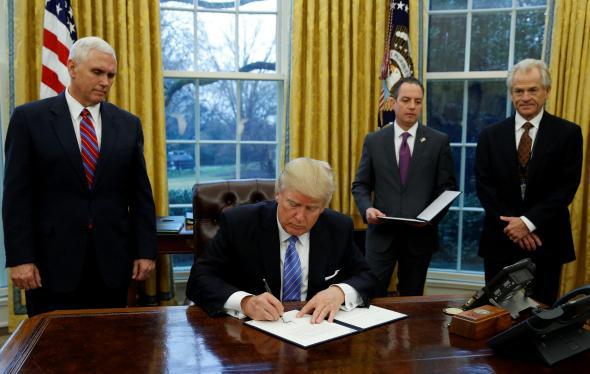On Monday, Donald Trump began his formal assault on women’s rights by reinstating and massively expanding the “global gag rule,” an anti-abortion policy created by President Ronald Reagan and implemented by every Republican president since. The original rule prohibited all recipients of international family planning funds from providing abortion-related care, referring patients to abortion providers, or giving women information about abortions. Trump’s immense expansion of the rule gags all recipients of global health funding, which will effectively sabotage a huge number of health programs in the developing world, particularly those that treat HIV/AIDS.
Unfortunately for Trump, a significant portion of this rule—which President Barack Obama suspended throughout his two terms—is plainly unconstitutional under a landmark 2013 Supreme Court decision. While government may prohibit the use of federal funds for abortion-related medical treatment and counseling, it may not bar recipients of these funds from using other money to provide abortion-related referrals and information. Such censorship qualifies as an “unconstitutional condition” that runs afoul of the First Amendment. Nongovernmental organizations subject to the gag should promptly ask the courts to remove this burden on their free speech rights.
Before 2013, the global gag rule was generally understood to be lawful under Rust v. Sullivan, a closely divided 1991 Supreme Court decision. Rust involved a challenge to a condition placed on organizations that received federal funds through Title X of the Public Health Service Act. Title X programs, Congress insisted, must not advocate for abortion as a method of family planning. This restriction undoubtedly chilled the speech of those doctors participating in Title X programs who wished to inform patients about the possibility of abortion. Title X grantees sued, alleging a violation of the First Amendment.
The Supreme Court narrowly upheld the rule, explaining that Congress had not actually suppressed speech but merely defined the scope of the programs it chose to fund. Congress, the court held, can lawfully forbid discussion of abortion in projects funded through Title X. It cannot, however, forbid doctors who participate in Title X programs from advocating for abortion in other, separately funded programs. As the court described this distinction, “the Title X grantee can continue to … engage in abortion advocacy; it simply is required to conduct those activities through programs that are separate and independent from the project that receives Title X funds.” In other words, Title X recipients can advocate for abortion; they just can’t do it using Title X money.
In 2013, the Supreme Court gave teeth to this distinction, drawing a much clearer line “between conditions that define the federal program” (which are constitutional) “and those that reach outside it” (which aren’t). The court considered a federal rule that limited the appropriation of funds for an HIV/AIDS prevention program to organizations that have “a policy explicitly opposing prostitution and sex trafficking.” Organizations that received money through the program, then, were barred from advocating for the decriminalization of sex work—even using other funding.
In an opinion written by Chief Justice John Roberts and joined even by conservative Justice Samuel Alito, the court struck down this condition as a First Amendment violation. Distinguishing the case from Rust, Roberts wrote that here the government had gone “beyond defining the limits of the federally funded program” by proscribing recipients from using separate funds to advocate their viewpoint. Unlike the rule in Rust, Roberts held, this policy proscribed funding recipients from “assert[ing] a contrary belief, or claim[ing] neutrality, when participating in activities on its own time and dime.” (Emphasis mine.) It therefore “cannot be confined within the scope of the Government program” and qualifies as “an unconstitutional condition” on funding recipients’ First Amendment rights.
Trump’s global gag rule is strikingly analogous to these facts. Although the administration alleged that the rule would prohibit the use of international aid money to provide abortion, that is false: The Helms amendment already forbids that. Instead, the gag rule primarily bars organizations that accept U.S. global health money from giving information about abortion, including referrals and medical advice. Critically, the rule bars a recipient from discussing abortion even on “its own time and dime.” Funding recipients are not only gagged from mentioning abortion when using U.S. money; they are gagged from mentioning abortion when using totally independent money with no connection to the U.S.
This restriction is unconstitutional. Unlike the policy in Rust, the global gag rule reaches beyond the scope of the government-funded programs to suppress independently funded speech. It censors doctors who wish to discuss abortion, or refer a patient to abortion-related services, on their own “time and dime,” simply because they accept U.S. aid. This condition chills speech outside of the U.S.-funded program—which the First Amendment disallows. To quote Roberts again, the rule infringes upon free speech by going “beyond defining the limits of the federally funded program to defining the recipient.”
Because the global gag rule was suspended when the court handed down its 2013 decision, nobody has yet had the opportunity to challenge its constitutionality in light of that crucial clarification of Rust. That should change soon. The rule is now in effect, and organizations that find their speech suppressed should sue to block it. Trump has no constitutional authority to censor doctors who want to discuss abortion outside of U.S.-funded programs. He may be able to stifle plenty of government speech, but the health organizations he hopes to silence remain within the ambit of the First Amendment.
